Multi-Wavelength Path Loss Model for Indoor VLC with Mobile Human Blockage
Abstract
:1. Introduction
1.1. Literature Review
1.2. Contribution of This Paper
- A novel path loss model is proposed which contains the multi-wavelength path loss under free space propagation and the blockage probability (BP) caused by the mobile human blockage. To the authors’ knowledge, this is the first path loss model that considers the impact of wavelength dependence combined with mobile human blockage.
- The wavelength dependence of path loss is investigated in both the single-LED and the multi-LED scenarios. The multi-wavelength path loss under free space propagation is modeled to describe the path loss in the non-blockage state. The small RMSE of the derived parameters shows that our proposed models have the goodness of fit to the simulated data.
- The impact of mobile human blockage on path loss is studied in both the single-LED and the multi-LED scenarios. The BP is modeled based on a realistic human moving trajectory and a geometry-based human body shadowing calculation method. A human moving trajectory generating algorithm is established which is capable of producing trajectories with realistic human walking behavior in the indoor scenario.
1.3. Paper Organization
2. Multi-Wavelength Path Loss Model with Human Blockage
2.1. VLC Channel Model
2.2. Multi-Wavelength Path Loss with Human Blockage in Single-LED Scenario
2.3. Multi-Wavelength Path Loss with Human Blockage in Multi-LED Scenario
3. Multi-Wavelength Path Loss Analysis and Modeling under Free Space Propagation
3.1. Multi-Wavelength Path Loss Model of Free Space Propagation in Single-LED Scenario
3.2. Multi-Wavelength Path Loss Model of Free Space Propagation in Multi-LED Scenario
4. Blockage Probability Analysis and Modeling
4.1. Human Moving Trajectory Generating
| Algorithm 1 Human Moving Trajectory Generator |
|
4.2. Human Body Shadowing Calculation Method
4.3. Blockage Probability Model in Single-LED Scenario
4.4. Blockage Probability Model in Multi-LED Scenario
5. Conclusions
Author Contributions
Funding
Data Availability Statement
Acknowledgments
Conflicts of Interest
References
- Zhang, J.; Lin, J.; Tang, P.; Zhang, Y.; Xu, H.; Gao, T.; Miao, H.; Chai, Z.; Zhou, Z.; Li, Y.; et al. Channel measurement, modeling, and simulation for 6G: A survey and tutorial. arXiv 2023, arXiv:2305.16616. [Google Scholar]
- Zhang, J.; Tang, P.; Yu, L.; Jiang, T.; Tian, L. Channel measurements and models for 6G: Current status and future outlook. Front. Inf. Technol. Electron. Eng. 2020, 21, 39–61. [Google Scholar] [CrossRef]
- Yin, Y.; Tang, P.; Liu, B.; Zhang, J.; Xia, L.; Liu, B. The comparison and analysis of different noise models for visible light communication. In Proceedings of the International Conference on Frontiers of Electronics, Information and Computation Technologies, Seoul, Republic of Korea, 19–21 February 2021. [Google Scholar]
- Khreishah, A.; Shao, S.; Gharaibeh, A.; Ayyash, M.; Elgala, H.; Ansari, N. A hybrid RF-VLC system for energy efficient wireless access. IEEE Trans. Green Commun. Netw. 2018, 2, 932–944. [Google Scholar] [CrossRef]
- Hussain, B.; Li, X.; Che, F.; Yue, C.P.; Wu, L. Visible light communication system design and link budget analysis. J. Light. Technol. 2015, 33, 5201–5209. [Google Scholar] [CrossRef]
- Alsalami, F.M.; Aigoro, N.; Mahmoud, A.A.; Ahmad, Z.; Haigh, P.A.; Haas, O.C.; Rajbhandari, S. Impact of vehicle headlights radiation pattern on dynamic vehicular VLC channel. J. Light. Technol. 2021, 39, 3162–3168. [Google Scholar] [CrossRef]
- Mmbaga, P.F.; Thompson, J.; Haas, H. Performance analysis of indoor diffuse VLC MIMO channels using angular diversity detectors. J. Light. Technol. 2015, 34, 1254–1266. [Google Scholar] [CrossRef]
- Sharda, P.; Reddy, G.S.; Bhatnagar, M.R.; Ghassemlooy, Z. A comprehensive modeling of vehicle-to-vehicle based VLC system under practical considerations, an investigation of performance, and diversity property. IEEE Trans. Commun. 2022, 70, 3320–3332. [Google Scholar] [CrossRef]
- Zhu, X.; Wang, C.; Huang, J.; Chen, M.; Haas, H. A novel 3D non-stationary channel model for 6G indoor visible light communication systems. IEEE Trans. Wirel. Commun. 2022, 21, 8292–8307. [Google Scholar] [CrossRef]
- Hussein, A.T.; Elmirghani, J.M. Mobile multi-gigabit visible light communication system in realistic indoor environment. J. Light. Technol. 2015, 33, 3293–3307. [Google Scholar] [CrossRef]
- Tong, Y.; Tang, P.; Zhang, J.; Yin, Y.; Liu, S.; Liu, B.; Liu, B.; Liu, G.; Xia, L. Measurement-based optical path loss model for indoor visible light communication. In Proceedings of the 2022 IEEE Globecom Workshops (GC Wkshps), Rio de Janeiro, Brazil, 4–8 December 2022. [Google Scholar]
- Singh, A.; Ghatak, G.; Srivastava, A.; Bohara, V.A.; Jagadeesan, A.K. Performance analysis of indoor communication system using off-the-shelf LEDs with human blockages. IEEE Open J. Commun. Soc. 2021, 2, 187–198. [Google Scholar] [CrossRef]
- Wu, Z.; Ismail, M.; Kong, J.; Serpedin, E.; Wang, J. Channel characterization and realization of mobile optical wireless communications. IEEE Trans. Commun. 2020, 68, 6426–6439. [Google Scholar] [CrossRef]
- Fahimeh, A.; Hossien, B.; Lina, B.; Sami, M.; Murat, U. Comparative characterization of indoor VLC and MMW communications via ray tracing simulations. IEEE Access 2023, 11, 90345–90357. [Google Scholar]
- Faheem, A.; Sathisha, R.; Jyothsna, M.; Varun, R. Path-Loss optimized indoor laser-based visible light communication system for variable link length gigabit-class communication. IEEE Photonics J. 2020, 12, 1–12. [Google Scholar]
- Feng, L.; Yang, H.; Hu, R.; Wang, J. MmWave and VLC-based indoor channel models in 5G wireless networks. IEEE Wirel. Commun. 2018, 25, 70–77. [Google Scholar] [CrossRef]
- Liu, S.; Tang, P.; Tong, Y.; Yin, Y.; Li, L.; Niu, A.; Xia, L.; Zhang, J. Impact of device specifications on VLC path loss and system performance: An empirical study. In Proceedings of the 2023 IEEE/CIC International Conference on Communications in China (ICCC), Dalian, China, 10–12 August 2023. [Google Scholar]
- Miramirkhani, F. A path loss model for link budget analysis of indoor visible light communications. Electrica 2021, 21, 242–249. [Google Scholar] [CrossRef]
- Bielsa, G.; Palacios, J.; Loch, A.; Steinmetzer, D.; Casari, P.; Widmer, J. Indoor localization using commercial off-the-shelf 60 GHz access points. In Proceedings of the 2018 IEEE Conference on Computer Communications (INFOCOM), Honolulu, HI, USA, 16–19 April 2018. [Google Scholar]
- Huo, Y.; Dong, X.; Ferdin, N. Distributed reconfigurable intelligent surfaces for energy-efficient indoor terahertz wireless communications. IEEE Internet Things J. 2023, 10, 2728–2742. [Google Scholar] [CrossRef]
- Xiang, Y.; Zhang, M.; Kavehrad, M.; Chowdhury, M.S.; Liu, M.; Wu, J.; Tang, X. Human shadowing effect on indoor visible light communications channel characteristics. Opt. Eng. 2014, 53, 086113. [Google Scholar] [CrossRef]
- Donmez, B.; Miramirkhani, F. Path loss and RMS delay spread model for VLC-based patient health monitoring system. In Proceedings of the 2022 4th West Asian Symposium on Optical and Millimeter-wave Wireless Communications (WASOWC), Kumamoto, Japan, 23 April 2022. [Google Scholar]
- Miramirkhani, F.; Uysal, M. Channel modeling and characterization for visible light communications. IEEE Photonics J. 2015, 7, 7905616. [Google Scholar] [CrossRef]
- Ghassemlooy, Z.; Popoola, W.; Rajbhandari, S. Optical Wireless Communications: System and Channel Modelling with Matlab; CRC Press: Boca Raton, FL, USA, 2019. [Google Scholar]
- Barry, J.R.; Kahn, J.M.; Krause, W.J.; Lee, E.A.; Messerschmitt, D.G. Simulation of multipath impulse response for indoor wireless optical channels. IEEE J. Sel. Areas Commun. 1993, 11, 367–379. [Google Scholar] [CrossRef]
- Lee, K.; Park, H.; Barry, J.R. Indoor channel characteristics for visible light communications. IEEE Commun. Lett. 2011, 15, 217–219. [Google Scholar] [CrossRef]
- Chvojka, P.; Zvanovec, S.; Haigh, P.A.; Ghassemlooy, Z. Channel characteristics of visible light communications within dynamic indoor environment. J. Light. Technol. 2015, 33, 1719–1725. [Google Scholar] [CrossRef]
- Komine, T.; Nakagawa, M. Fundamental analysis for visible light communication system using LED lights. IEEE Trans. Consum. Electron. 2004, 50, 100–107. [Google Scholar] [CrossRef]
- Eldeeb, H.B.; Uysal, M.; Mana, S.M.; Hellwig, P.; Hilt, J.; Jungnickel, V. Channel modelling for light communications: Validation of ray tracing by measurements. In Proceedings of the 2020 12th International Symposium on Communication Systems, Networks and Digital Signal Processing (CSNDSP), London, UK, 23–26 October 2020. [Google Scholar]
- Soltani, M.D.; Purwita, A.A.; Zeng, Z.; Haas, H.; Safari, M. Modeling the random orientation of mobile devices: Measurement, analysis and LiFi use case. IEEE Trans. Commun. 2018, 67, 2157–2172. [Google Scholar] [CrossRef]
- Mohler, B.J.; Thompson, W.B.; Creem-Regehr, S.H.; Pick, H.L.; Warren, W.H. Visual flow influences gait transition speed and preferred walking speed. Exp. Brain Res. 2007, 181, 221–228. [Google Scholar] [CrossRef]
- Rhee, I.; Shin, M.; Hong, S.; Lee, K.; Kim, S.J.; Chong, S. On the levy-walk nature of human mobility. IEEE/ACM Trans. Netw. 2011, 19, 630–643. [Google Scholar] [CrossRef]
- Hosseinianfar, H.; Lian, J.; Brandt-Pearce, M. Probabilistic shadowing model for indoor optical wireless communication systems. In Proceedings of the 2019 53rd Asilomar Conference on Signals, Systems, and Computers, Pacific Grove, CA, USA, 3–6 November 2019. [Google Scholar]
- Tang, T.; Shang, T.; Li, Q.; Qian, P.H. Shadowing effects on indoor visible light communication channel modeling. In Proceedings of the 2020 Information Communication Technologies Conference (ICTC), Nanjing, China, 29–31 May 2020. [Google Scholar]
- Tang, T.; Shang, T.; Li, Q. Impact of multiple shadows on visible light communication channel. IEEE Commun. Lett. 2020, 25, 513–517. [Google Scholar] [CrossRef]
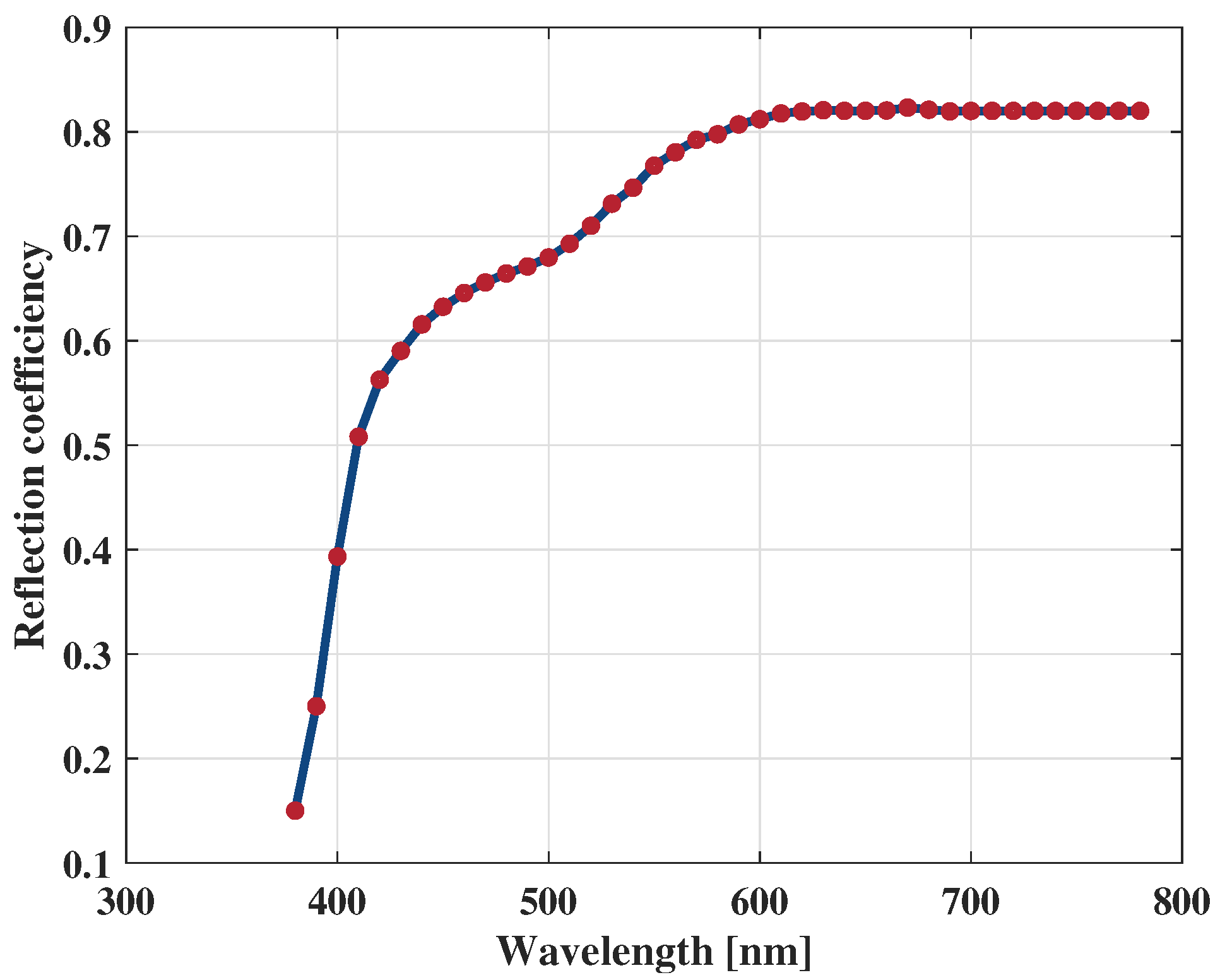
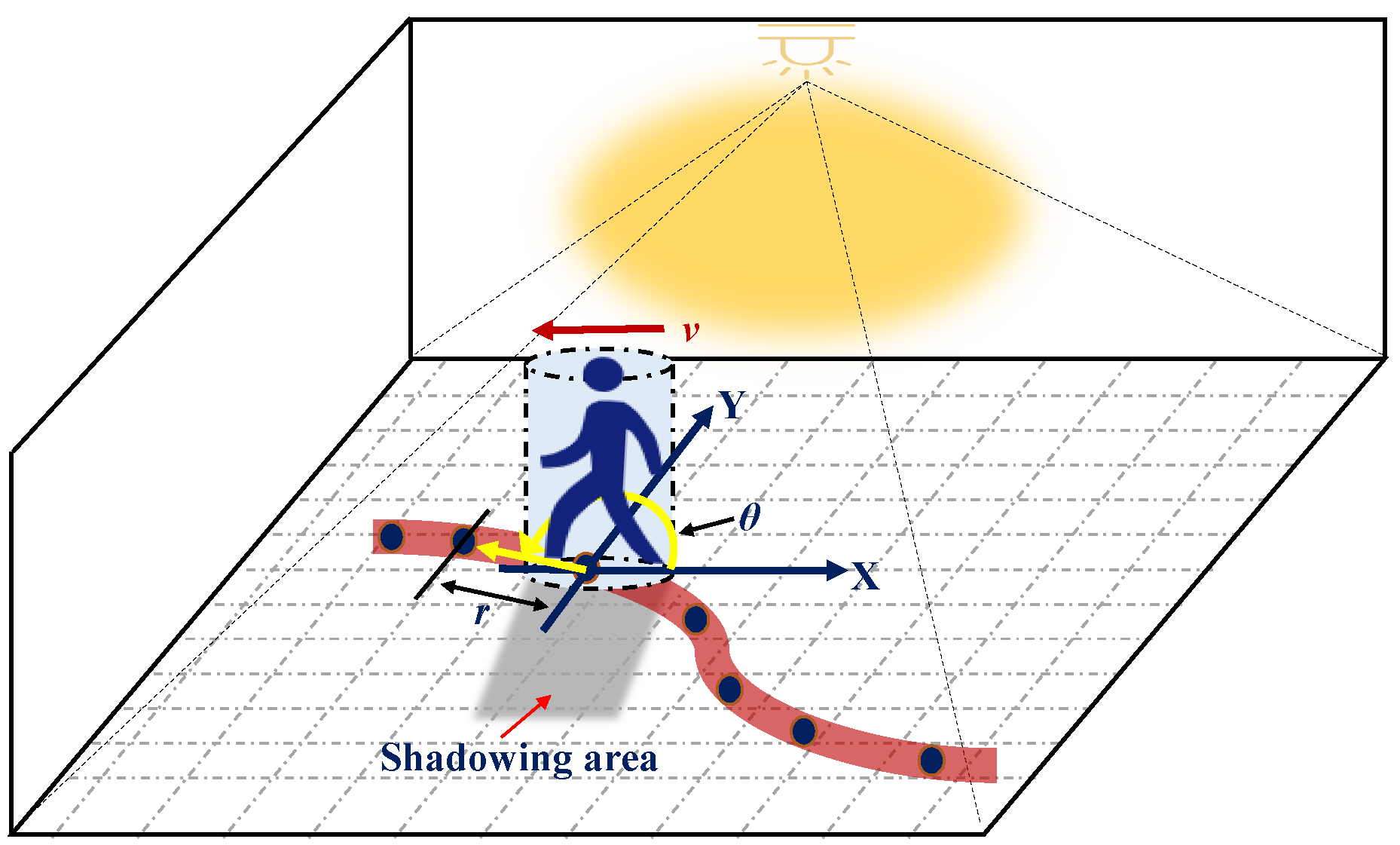
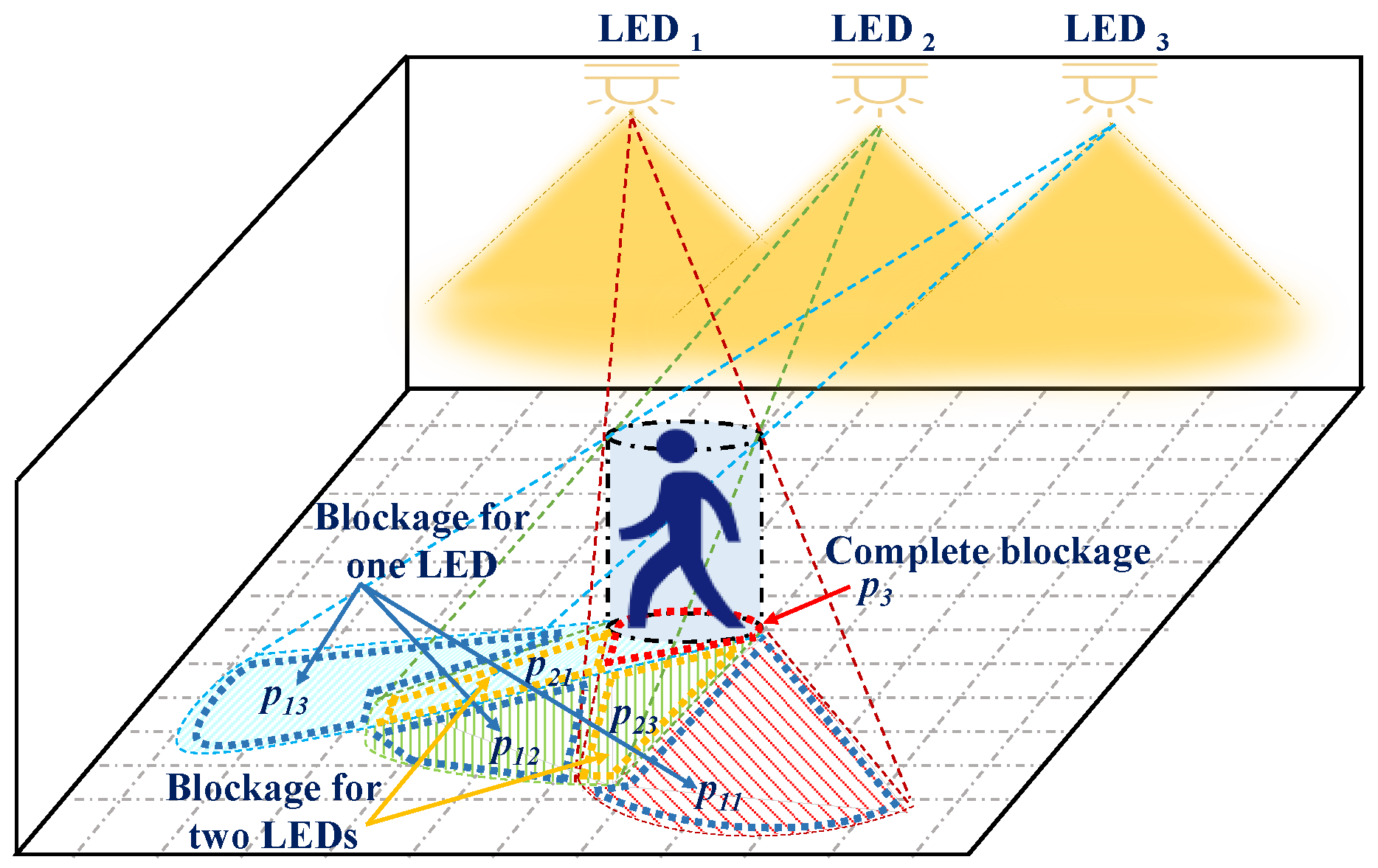
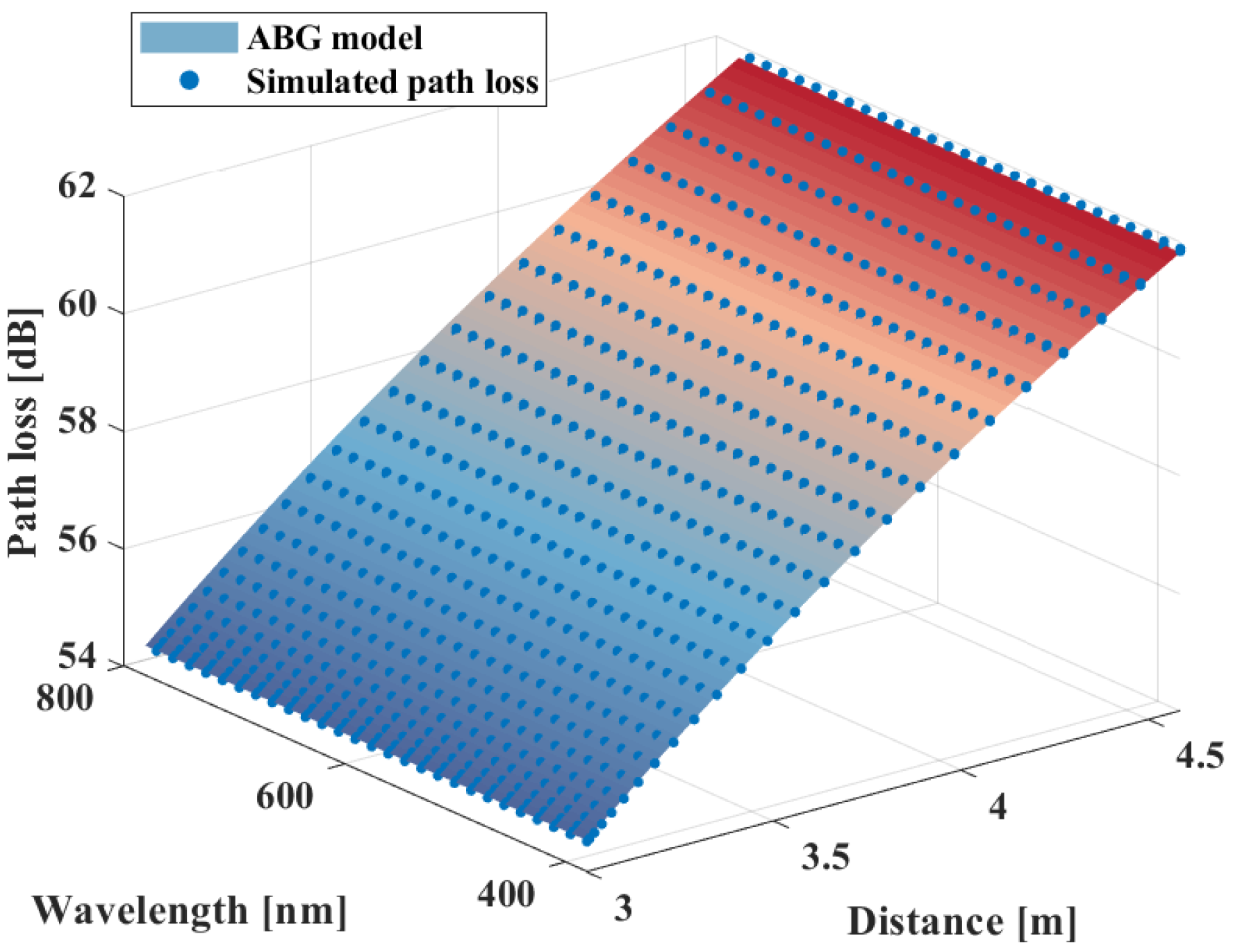
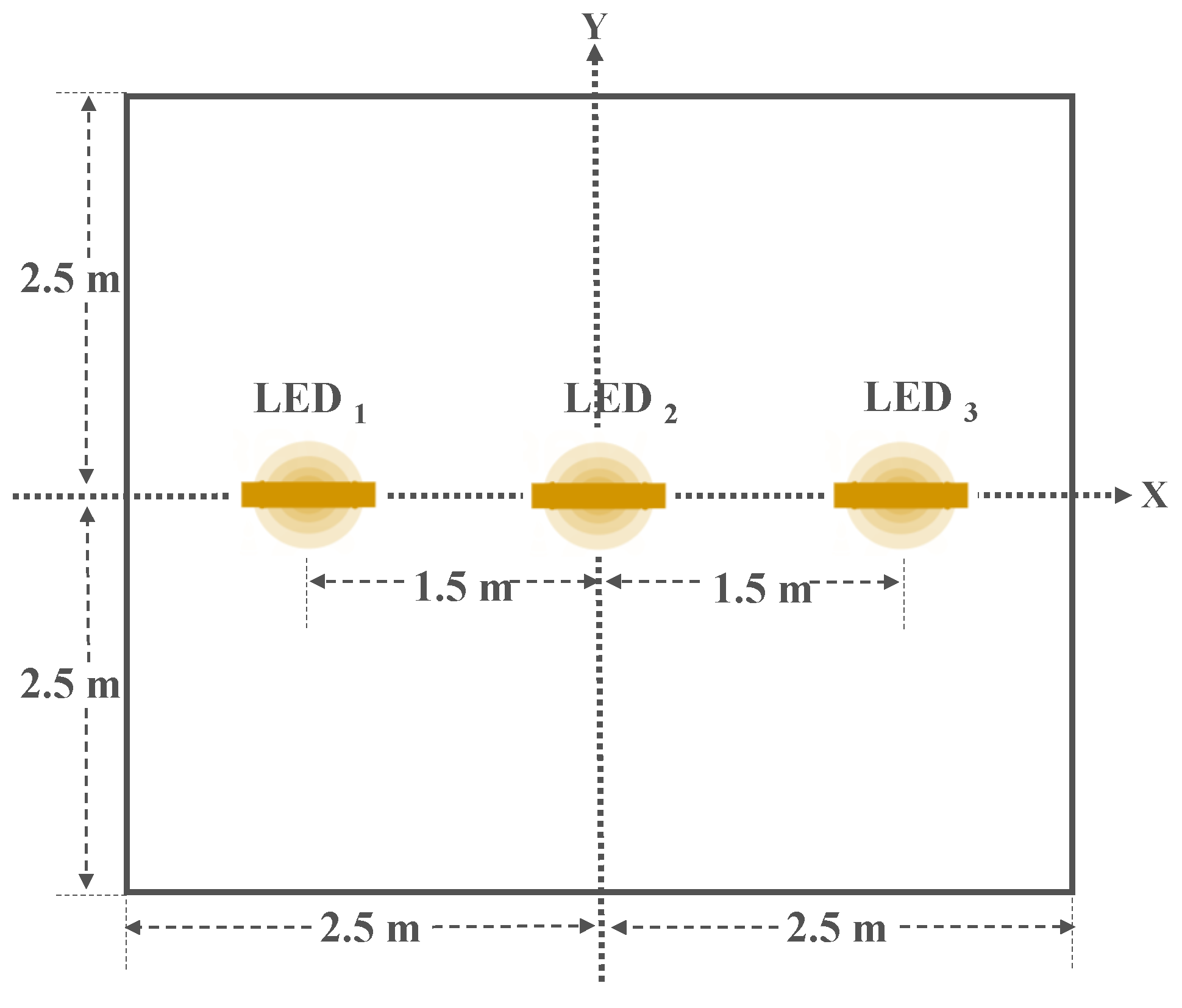
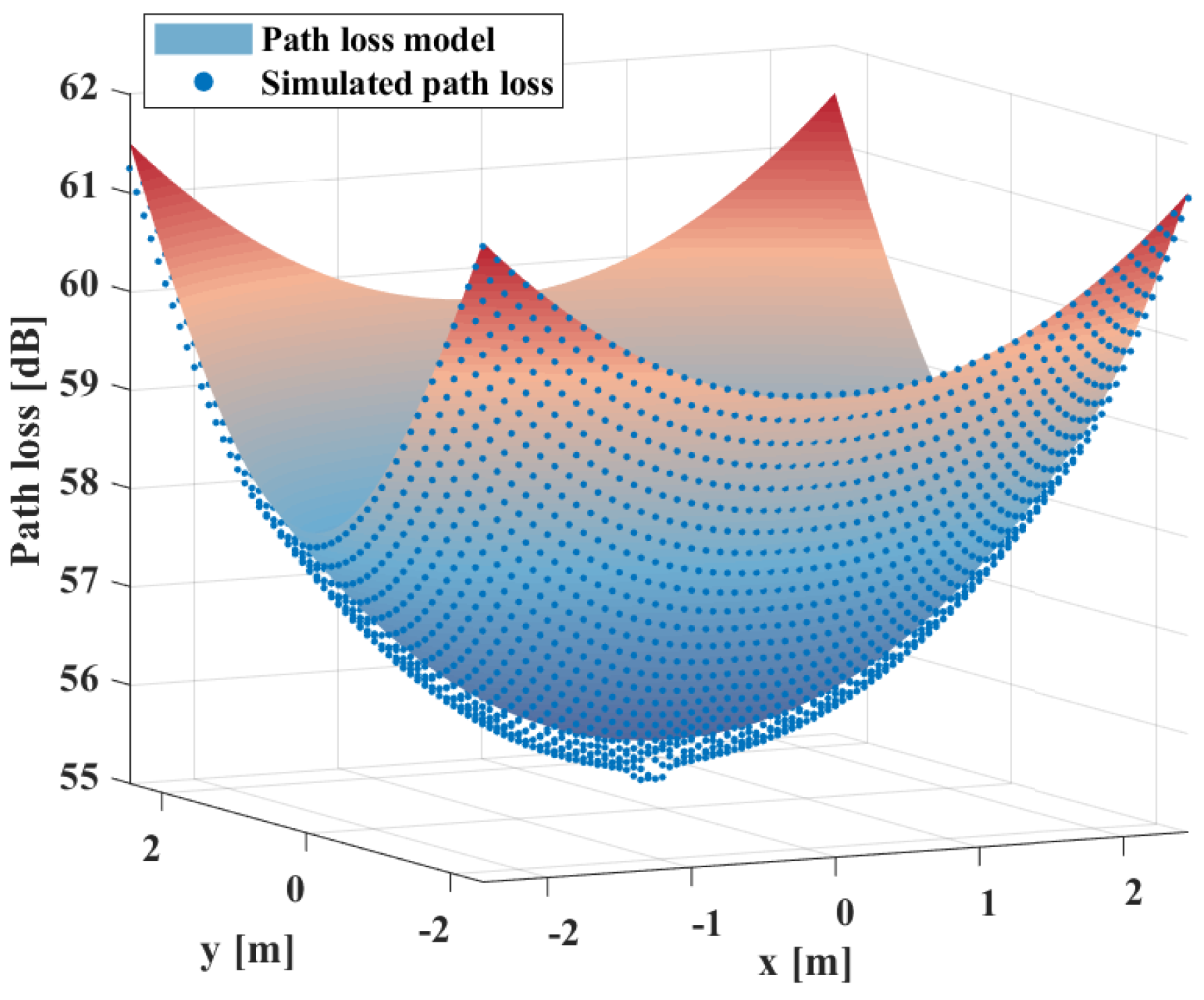
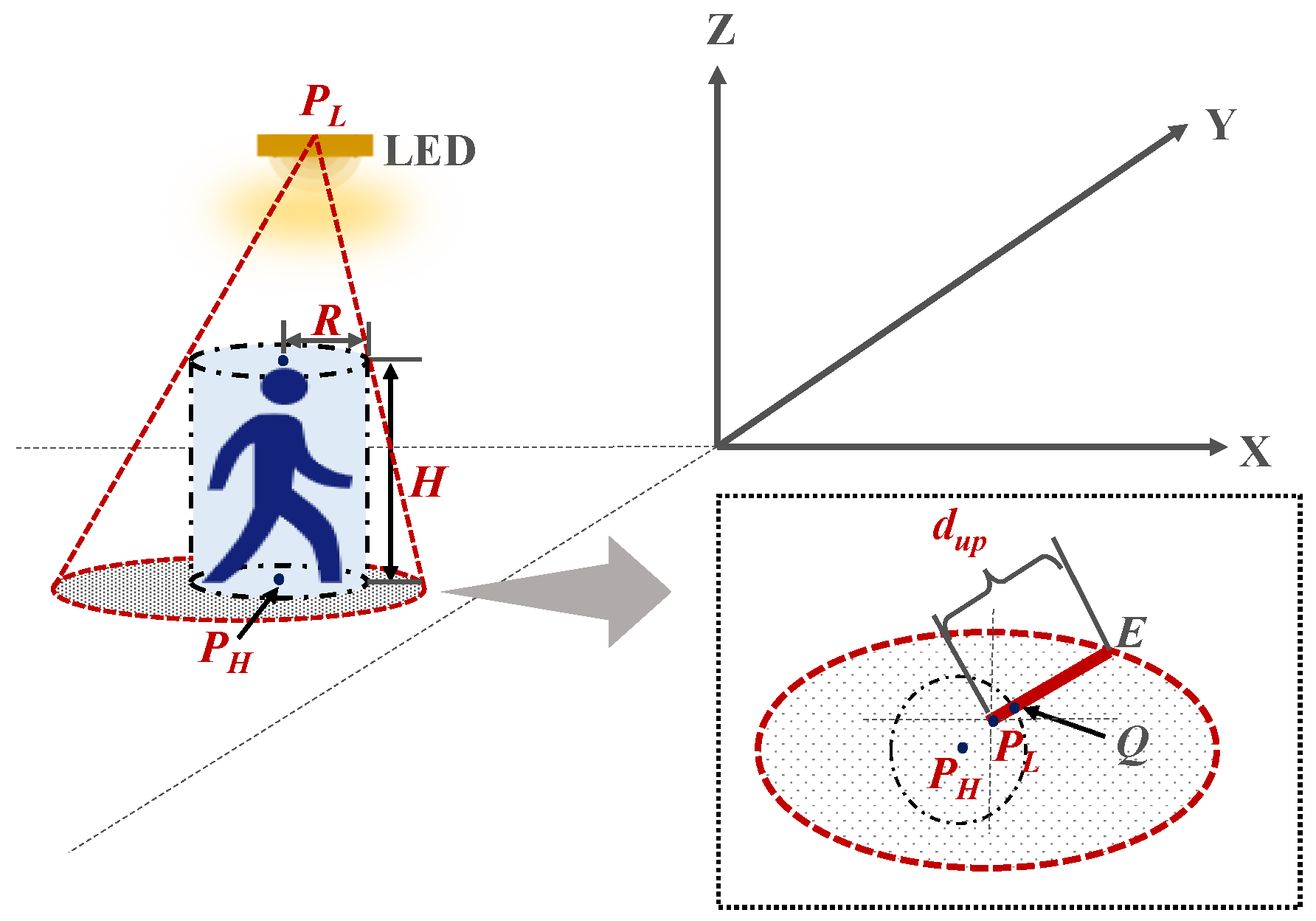
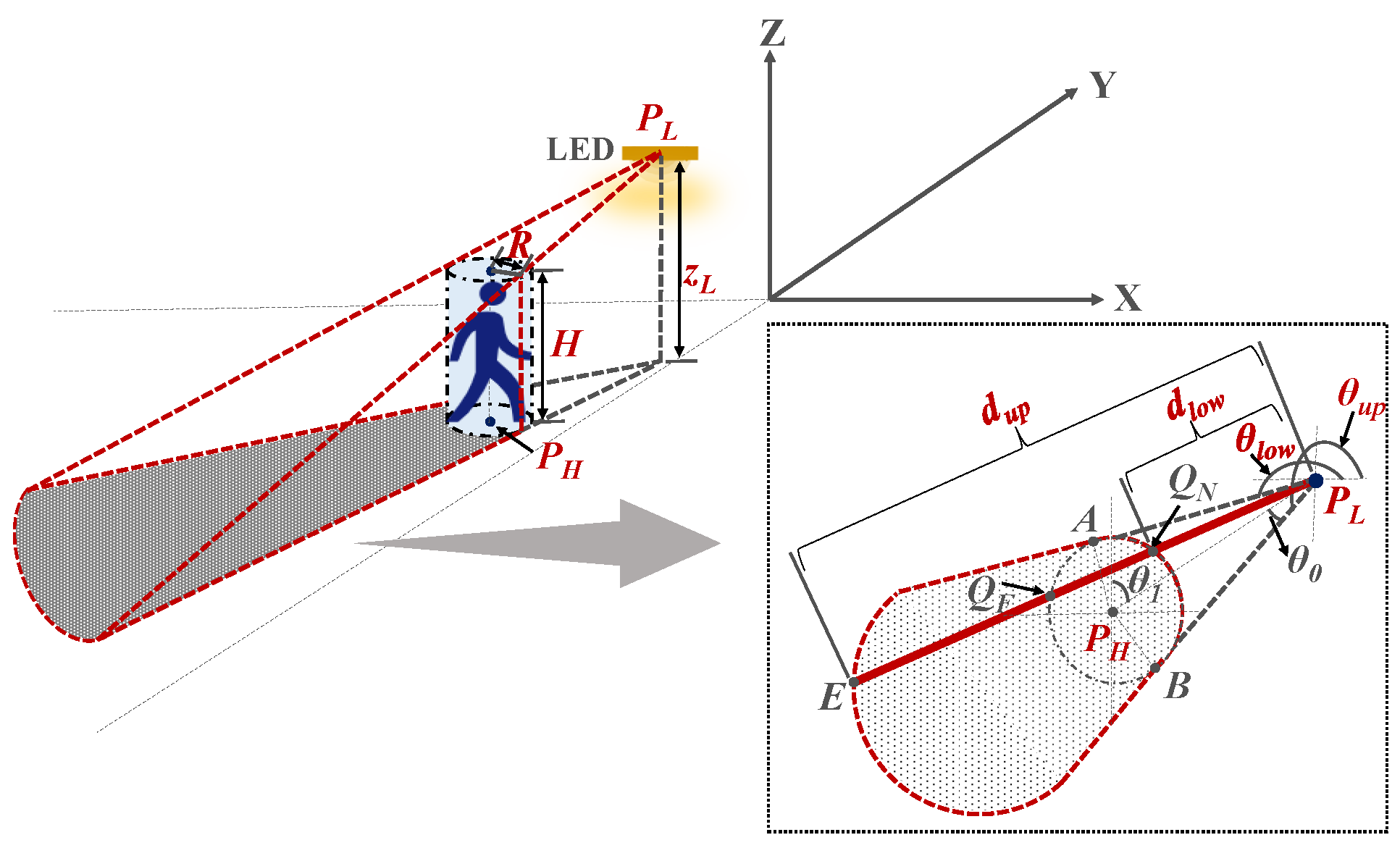
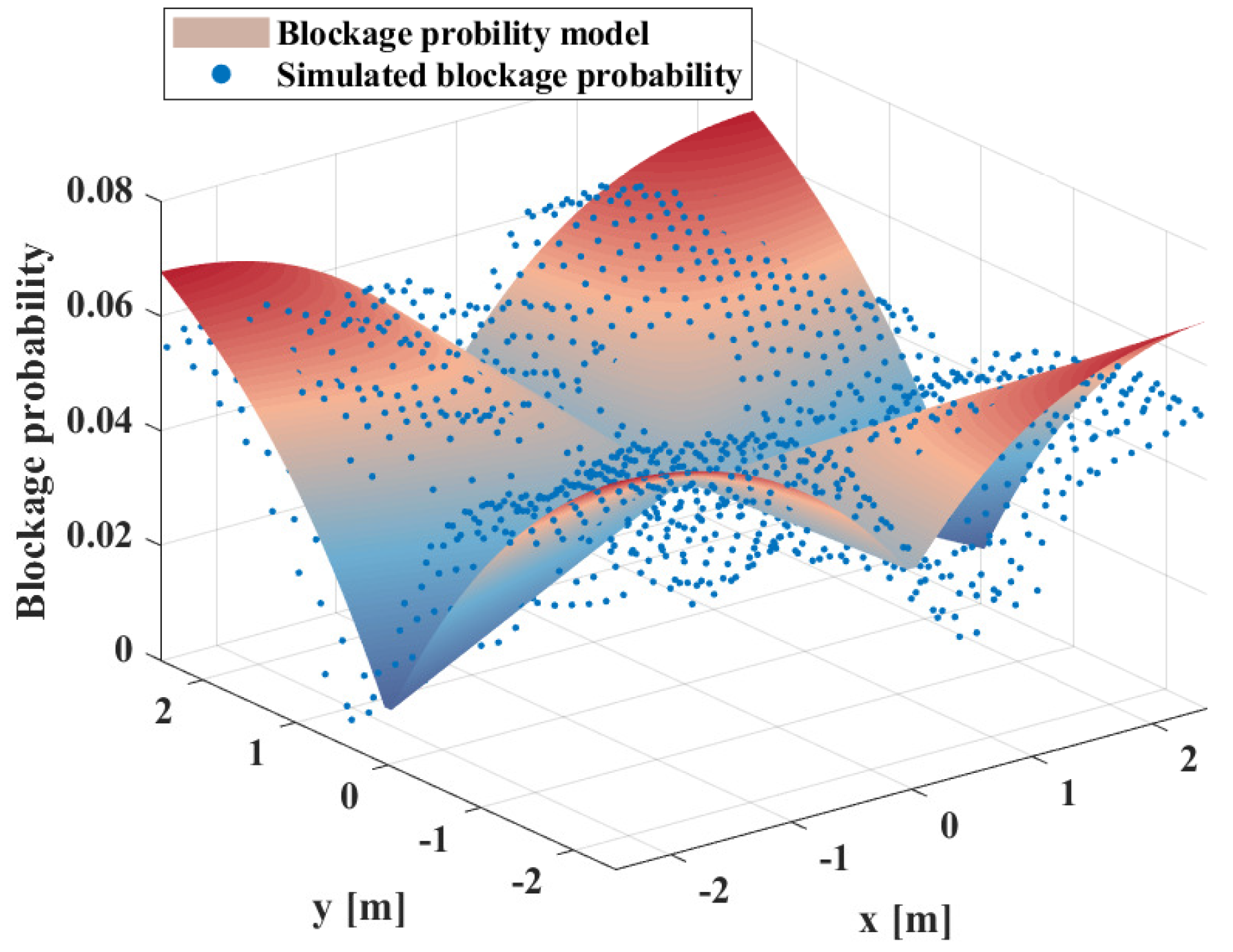

| Parameter | Value |
|---|---|
| Scenario size | 5 m × 5 m × 3 m |
| LED Power in the single-LED scenario | 1 W |
| LED Power in the 3-LED scenario | 0.33 W |
| Semi-angle at half power | |
| Mode number | 1 |
| Coating material | Plaster |
| Reflection coefficient | Wavelength-dependent |
| Length of reflecting elements | 0.1 m |
| Field of vision | |
| Physical area of PD | 1 |
| Transmission coefficient of the optical filter | 1 |
| Refractive index of len at PD | 1 |
| Parameter | Value |
|---|---|
| Human height | 1.71 m [33] |
| Human weight | 0.30 m [34] |
| Number of generated steps | 20,000 |
| Time resolution | 1 s |
| The maximum speed | 2.1 m/s |
| The minimum speed | 1 m/s |
| The maximum sojourn time | 2 s |
| The minimum sojourn time | 1 s |
| Positive parameter | 0.5 [13] |
| Positive parameter | 1 [13] |
| Quadrant | ||
|---|---|---|
| 1 | ||
| 2 | 90 + | 90 + |
| 3 | ||
| 4 | 270 + | 270 + |
Disclaimer/Publisher’s Note: The statements, opinions and data contained in all publications are solely those of the individual author(s) and contributor(s) and not of MDPI and/or the editor(s). MDPI and/or the editor(s) disclaim responsibility for any injury to people or property resulting from any ideas, methods, instructions or products referred to in the content. |
© 2023 by the authors. Licensee MDPI, Basel, Switzerland. This article is an open access article distributed under the terms and conditions of the Creative Commons Attribution (CC BY) license (https://creativecommons.org/licenses/by/4.0/).
Share and Cite
Yin, Y.; Tang, P.; Zhang, J.; Hu, Z.; Xia, L.; Liu, G. Multi-Wavelength Path Loss Model for Indoor VLC with Mobile Human Blockage. Electronics 2023, 12, 5036. https://doi.org/10.3390/electronics12245036
Yin Y, Tang P, Zhang J, Hu Z, Xia L, Liu G. Multi-Wavelength Path Loss Model for Indoor VLC with Mobile Human Blockage. Electronics. 2023; 12(24):5036. https://doi.org/10.3390/electronics12245036
Chicago/Turabian StyleYin, Yue, Pan Tang, Jianhua Zhang, Zheng Hu, Liang Xia, and Guangyi Liu. 2023. "Multi-Wavelength Path Loss Model for Indoor VLC with Mobile Human Blockage" Electronics 12, no. 24: 5036. https://doi.org/10.3390/electronics12245036





